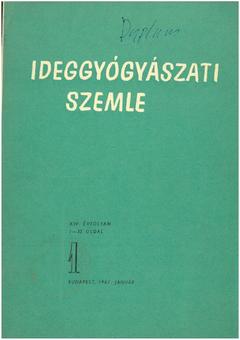The eLitMed.hu medical portal uses computer cookies for convenient operation. Detailed information can be found in the Cookie-policy.
Clinical Neuroscience - 1961;14(01)
Content
[Malignant angioblastoma spreading between the soft tissues ("Lindau disease") ]
[The author describes a case of a rapidly progressive, fatal cerebellar solid angioblastoma (Lindau), which spread diffusely along the blood vessels and between the soft tissues. He briefly reviews the literature on the subject, which did not find angioblastoma spreading in a similar manner. ]
[Intravenous urea: new agent for intracranial pressure increase in intracranial pressure]
[Our experience, which we have presented in the form of a preliminary bulletin because of the small number of cases, suggests that i.v. urea will be a much more effective and reliable tool than hypertonic solutions (dextrose, etc.) in the treatment of intracranial hypertension. The development of a side-effect-free home preparation is currently underway; we will report on clinical trials of this on larger material and on studies of the mechanism of action. ]
[Our experience with Urevert, Report on our surgical observations ]
[The authors describe their experience with Urevert, a new intracranial pressure reliever. It was used to reduce increased intracranial pressure caused by brain tumours (4), ruptured aneurysms (2) and subdural haematoma (1) in 7 patients. They observed that Urevert is an easy to administer and accurately dosed dehydrating agent. It is excellent for reducing increased intracranial pressure. It reaches its maximum effect within 1-2 hours and can therefore be administered primarily as a preoperative preparation. No unpleasant side effects have been observed. Indication is wide, contraindications are active intracranial haemorrhages and various severe liver and kidney diseases.]
[Catamnosis of children with elective mutism]
[The author describes 11 cases of elective mutism - with particular reference to catamnestic data recorded years later. The symptom usually comes to attention in preschool or during school enrolment. It is strikingly often associated with vegetative dystonia, enuresis and mental retardation. Although polyaetiological factors are frequently present in the history, the author is under the impression that in a significant proportion of cases, a congenitally reduced speech ability is primarily responsible for the manifestation of e.m. The therapeutic approach varies according to the type of reaction and pathogenesis. He concludes that, when sufficient time was available, the therapeutic outcome was durable in the vast majority of cases (7 complete cures, 2 improvements). The catamnestic monitoring of the therapeutic outcome also serves the purpose of facilitating and providing empirical support for the prognosis.]
[Retroolivar softenings as vertebralis complications of angiography]
[In two cases of attempted carotid AG, the contrast material entered the vertebral artery, resulting in fatal retroolivar atrophy and haemorrhage, both of which were associated with the posterior blood supply area of the cerebellar inf. In one case very pronounced, in the other mild vascular lesions may have been a predisposing factor for AG complications. No such localized complication has been reported in the literature. ]
[Book review]
[Müller--Hegemann : Psychotherapie. 1957. Veb Verlag Volk u. Gesundheit. Berlin. 264 0. ]
1.
Clinical Neuroscience
[Headache registry in Szeged: Experiences regarding to migraine patients]2.
Clinical Neuroscience
[The new target population of stroke awareness campaign: Kindergarten students ]3.
Clinical Neuroscience
Is there any difference in mortality rates of atrial fibrillation detected before or after ischemic stroke?4.
Clinical Neuroscience
Factors influencing the level of stigma in Parkinson’s disease in western Turkey5.
Clinical Neuroscience
[The effects of demographic and clinical factors on the severity of poststroke aphasia]1.
2.
Clinical Oncology
[Pancreatic cancer: ESMO Clinical Practice Guideline for diagnosis, treatment and follow-up]3.
Clinical Oncology
[Pharmacovigilance landscape – Lessons from the past and opportunities for future]4.
5.



